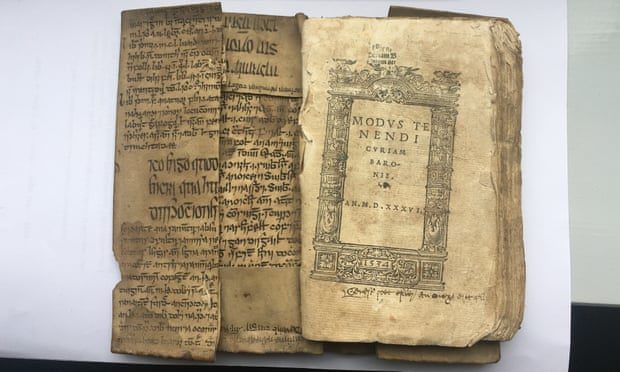
The manuscript had been trimmed, folded and stitched to the spine of a pocket-sized Latin manual about local administration, which was printed in London in the 1530s. It had been owned by the same family in Cornwall since the 16th century. When they decided to satisfy their curiosity about the unusual binding last year, they consulted University College Cork professor of modern Irish Pádraig Ó Macháin, who said he "knew pretty much straight away" that it was a significant find.
"It really was very, very exciting, one of those moments which makes life worthwhile," said Ó Macháin.
Professor Aoibheann Nic Dhonnchadha of the Dublin Institute for Advanced Studies, an expert on medieval Irish medicine, identified the text as a fragment of Ibn Sīna's Canon of Medicine, a previously unknown Irish translation. Ibn Sīna lived between 980 and 1037 and was one of the Islamic golden age's most influential scholars.
"While there are references to Avicenna scattered through other medical texts in Irish, we now know, for the first time, that the Canon was translated into Irish. This fragment must have come from a seriously big manuscript," said Ó Macháin. "The use of parchment cut from old manuscripts as a binding for later books is not unusual in European tradition, but this is the first time that a case has come to light of such a clear example of the practice in a Gaelic context."
Sīna's Canon of Medicine was a medical encyclopaedia which was seen as the standard medical text in the Islamic world and across Europe for more than six centuries. The Irish fragment includes parts of the opening chapters, tackling the physiology of the jaw, the nose and the back, with the section on the nose the least fragmentary. It details in particular the "three uses" of the bones of the nose: "to retain the air in its vacuum to strengthen the brain constantly", to help "to articulate the sound of every letter", and "the third use: the superfluities that are expelled from the brain, part of them nourish the nose and the remainder is expelled from it as a superfluity. And it is for that reason that we have called the bones that are in the nose ... a helping instrument, for it is through them that the superfluities are expelled, like the blowing of a bellows."
Ó Macháin said that medical scholarship in medieval Gaelic Ireland was on a par with that practised on the continent, with evidence of Irish scholars travelling to European medical schools and bringing their learning back to Ireland. "The reason [the fragment] was translated was that Irish was the language of learning in medieval Ireland, whereas Latin fulfilled that role everywhere else," he said.
It would have been cut up, he said, following the Elizabethan conquest of Ireland, which put an end to the old Gaelic society. "Early universities in Ireland, supported by the Gaelic lordships, that all fell asunder as the Elizabethan conquest proceeded. Books like these were destroyed, and others were damaged and cut up, and it's in that wider context you have to see whoever owned this book clearly came into possession of some such manuscript and thought nothing of trimming it and making a binding of it," he said.
The book's owners agreed that the binding should be removed, opened out and digitised. It can now be seen on the Irish Script on Screen website.
"The discovery and digitisation of the text was a scholarly adventure," said Ó Macháin. "One of those occasions when many people, not least the owners of the book, were working together towards a common purpose for the cause of pure learning. It was a pleasure to have been able to make it happen and to have been part of it."




R.C.